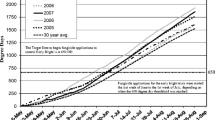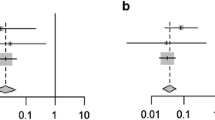Abstract
In northwest Washington State, fungicidal control of late blight caused byPhytophthora infestons was evaluated for three years. During 1977, a high rainfall year with supplemental sprinkler irrigations, all metalaxyl and chlorothalonil treatments reduced tuber rot at harvest, but only metalaxyl extended control of tuber rot after 4 months’ storage. During 1978, a high rainfall year, one application of metalaxyl sprayed over or dusted on potato seed pieces at planting or applied five times to foliage at 2 or 4 wk intervals gave excellent blight control equal to that with chlorothalonil applied to foliage every 2 wk.
In 1979, a low rainfall year,P. infestons did not kill plants in untreated plots until October. Five applications of metalaxyl sprayed every 2 wk on foliage did not control foliage blight. However, metalaxyl reduced foliage blight when dusted on cut potato seed pieces. Mancozeb sprayed every 2 wk also gave excellent control. The possibility that metalaxyl applied to foliage is effective in late blight control only when washed into the soil by rainfall or irrigation for uptake by roots is discussed.
Yields and percent U.S. No. 1 grade tubers were not significantly affected by any treatment in these 3-year trials.
Resumen
En el Estado de Washington en el noroeste de los EE.UU., se evaluó durante tres años el control por fungicidas del tizón tardio causado porPhytophthora infestons. Durante 1977, un año con un alto nivel de precipitaciones y con riego suplementario por aspersión, todos los tratamientos de metalaxil y clorotalonil redujeron la pudrición del tubérculo al momento de la cosecha. Pero sólo el metalaxil prolongó su control de la pudrición del tubérculo hasta después de 4 meses de almacenamiento.
Durante 1978, un año con un alto nivel de precipitaciones, una aplicación de matalaxil rociado o espolvoreado sobre los tubérculos-semillas en la siembra o aplicado cinco veces en el follaje a intervalos de 2 a 4 semanas, dio un excelente control del tizón tardío, igual que el control por clorotalonil aplicado al follaje cada 2 semanas.
En 1979, un año con un nivel bajo de precipitaciones,P. infestans no causó la muerte de las plantas en parcelas sin tratar hasta octubre. Cinco aplicaciones del metalaxil rociado en el follaje cada dos semanas no controlaron el tizón tardío. Sin embargo, el metalaxil redujo el tizón en el follaje al ser espolvoreado sobre los tubérculos-semillas cortados. El Mancoceb rociado cada dos semanas también dio un excelente control. Se discute la posibilidad de que el metalaxil aplicado en el follaje sea efectivo en el control del tizón tardio sólo al penetrar en el suelo con el agua de la lluvia o del riego y así ser asimilado por las raices.
Los rendimientos y el porcentaje del primer tamaño según escala estadounidense no resultaron significativamente afectados por ningún tratamiento en los ensayos de esos tres años.
Similar content being viewed by others
Literature Cited
Abdel-Rahman, M. 1978. Potato fungicides and disease control programs, 1977. Results of 1977 fungicide nematicide tests. Am Phytopath Soc 33:78–79.
Bruin, G.C.A., L.V. Edgington and B.D. Ripley. 1982. Bioactivity of the fungicide metalaxyl in potato tubers after foliage sprays. Can J Plant Pathol 4:353–356.
Cetas, R.C. 1979. Fungicide evaluations for potato late blight control, 1978. Results of 1978 fungicide nematicide tests. Am Phytopath Soc 34:69–70.
Cohen, Y., M. Reuveni and H. Eyal. 1979. The systemic antifungal activity of Ridomil againstPhytophthora infestons on tomato plants. Phytopathology 69:645–649.
Croxall, H.E. and L.P. Smith. 1976. The epidemiology of potato blight in the East Midlands 1923–74. Ann Appl Biol82:451–466.
Easton, G.D. and M.E. Nagle. 1983. Central Washington late blight epidemic of 1982- why it occurred and predictions of future epidemics. Washington State Potato Conf, Washington State Potato Commission, Moses Lake, WA. 5–8.
Easton, G.D. 1982. Late blight of potatoes and predictions of epidemics in arid central Washington State. Plant Dis 66:452–455.
Edgington, L.V., R.A. Martin, G.C. Bruin and I.M. Parsons. 1980. Systemic fungicides: a perspective after 10 years. Plant Dis 64:19–23.
Ellis, M.A., G.G. Grove and D.C. Ferree. 1981. Uptake and translocation of Ridomil in apple trees. Phytopathology 71:871. (Abstr)
Fry, W.E., R.I. Bruck and C.C. Mundt. 1979. Retardation of potato late blight epidemics by fungicides with eradicant and protectant properties. Plant Dis Rep 63:970–974.
Fry, W.E., T. Alway and G.R. Fohner. 1980. Efficacy of fungicides for control of potato late blight, 1979. Results of 1979 fungicide nematicide tests. Am Phytopath Soc 35:81–82.
Funch, U.C. and R. Heitefuss. 1976. Utersuchungen uber Okonomische Schadensschwellen fur Kraut- und Knollenfaule (Phytophthora infestons) im Kartoffelbau. Z Pflanzenkr Pflanzenchutz 83:705–729.
Gabrielson, R.L. and L.W. Getzin. 1979. Systemic pesticides for control of downy mildew and insects on cabbage transplants grown for seed production. Plant Dis Rep 63:131–135.
Hirst, J.M. and O.J. Steadman. 1956. The effect of height of observation in forecasting potato blight by Beaumont’s method. Plant Pathol 5:135–140.
Hirst, J.M. and O.J. Steadman. 1960. The epidemiology ofPhytophthora infestons. I. Climate, ecoclimate and phenology of disease outbreak. Ann Appl Biol 48:471–488.
Hyre, R.A. 1959. The relation of rainfall and temperature to late blight of potato at Burlington, Vermont. Plant Dis Rep 43:295–297.
Johnson, G.I., R.D. Davis and R.G. O’Brien. 1979. Soil application of CGA 48988-a systemic fungicide controllingPeronospora tabacina on tobacco. Plant Dis Rep 63: 212–215.
Krause, R.A., L.B. Massie and R.A. Hyre. 1975. Blitecast: a computerized forecast of potato late blight. Plant Dis Rep 59:95–98.
Locke, J.C., G.C. Papavizas and J.A. Lewis. 1979. Seed treatment with fungicides for control of Pythium seed rot of peas. Plant Dis Rep 63:725–728.
Manzer, F.E., O.P. Smith and E.A. Giggie. 1981. Fungicide control of late blight of potato, 1979. Results of 1980 fungicide nematicide tests. Am Phytopath Soc 36:68–69.
Mitchell, D.B. 1977–79. Climatology data, Washington. Nat Climatic Ctr, Asheville, NC. 81–83. No. 6–11.
Papavizas, G.C., F.W. Schwenk, J.C. Locke and J.A. Lewis. 1979. Systemic fungicides for controlling Phytophthora root rot and damping-off of soybean. Plant Dis Rep 63: 708–712.
Rowe, R.C. 1977. Control of late blight with systemic fungicides, 1976. Results of 1976 fungicide nematicide tests. Am Phytopath Soc 32:97–98.
Rowe, R.C. 1978. Control of late blight of potatoes with fungicides, 1977. Results of 1977 fungicide nematicide tests. Am Phytopath Soc 33:85.
Rowe, R.C. 1982. Translocation of metalaxyl and RE 26745 in potato and comparison of foliar and soil application for control ofPhytophthora infestons. Plant Dis 66:989–993.
Staub, T., H. Dahmen and F.J. Schwinn. 1978. Biological characterization of uptake and translocation of fungicidal acylalanines in grape and tomato plants. Z Pflanzenkr Pflanzenschutz 85:162–168.
Timmer, L.W. 1979. Preventative and systemic activity of experimental fungicides againstPhytophthora parasitica on citrus. Plant Dis Rep 63:324–327.
Urech, P.A., F.J. Schwinn and T. Staub. 1977. CGA 48988, a novel fungicide for the control of late blight, downy mildews and related soil-borne diseases. Proc 1977 Brit Crop Prot Conf 2:623–631.
Weis, G.G. and W.R. Stevenson. 1980. Potato fungicide spray trial, 1979. Results of 1979 fungicide nematicide tests. Am Phytopath Soc 35:86–87.
Zaki, A.I., G.A. Zentmyer and H.M. LeBaron. 1981. Systemic translocation of14C-labeled metalaxyl in tomato, avocado, andPersea indica. Phytopathology 71:509–514.
Author information
Authors and Affiliations
Additional information
Scientific paper no. SP 6524, Project 1709. Washington State University, College of Agriculture, Agricultural Research Center, Pullman 99164. Mention of a product used in these studies does not constitute a recommendation of the product by Washington State University over other products.
Rights and permissions
About this article
Cite this article
Easton, G.D., Nagle, M.E. Metalaxyl and other fungicides for control ofPhytophthora infestans on potato in northwest Washington State. American Potato Journal 61, 83–92 (1984). https://doi.org/10.1007/BF02852881
Accepted:
Issue Date:
DOI: https://doi.org/10.1007/BF02852881




